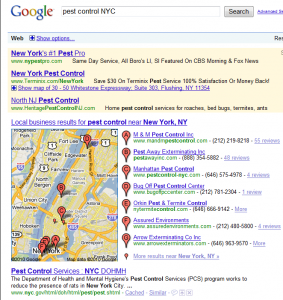
In our series on placing for local searches on Google, this is our last option and one of the toughest although there are still some smart things to do to attempt to reach local buyers. This article is for the scenario when you have a business that has one or several far flung locations but sells nationally.
Here’s what I’ve found works for location specific placements when you are selling nationally.
1. First, see our post from 4-8-14 on how to rank for one city. In this twist of one business selling nationally, again it is key to put all your location addresses in the footer of your website. If you have more than three or four locations, I would do a location page for your website and then just list the city and state names in the footer hyperlinking to your specific location page. You may have offices in only one city or two, but having the local addresses is still key. However I would add a tag line after the locations stating something like “Serving clients nationwide for 10 years.” Make sure in your content that you are talking about your nationwide services.
2. Here a page for each state may not work or may be too cumbersome and the truth is that a nationwide provider will be at a disadvantage when compared to a local provider for location specific searches. Make sure that any city you are located in however, does still get mentioned by location as you do still want to place locally for your branch offices.
3. Setting up a Google+ Local page for each location is really key for organic placement where you have a branch office. Take some time and put some thought into what you will write and make sure the pictures and videos if you have them (highly recommended) are unique to that location.
4. Where you can, make sure you validate your Google+ Local page. A PIN will be hard copied mailed to the physical address. Your staff needs to be vigilant to find this PIN envelope. It will look like junk mail and will have NO Google ID on it. Nothing will show on Google until you validate and then typically a two to four week delay after verification to show in the results is not uncommon.
For nationwide providers the reality is that to be visible locally you will need to move into paid search if you want prominence on local placement. There is simply no way to scam Google into showing a Google+ Local page or for that matter even be able to validate one where you do not have a physical location. By setting up your AdWords program to target local city names or state names with dynamic keyword insertion your ad will appear up at the top of the page for these important location searches just not in the organic section.
One caveat on this. I have found that when you can own the state organically, Google will preferentially show your results in many cases for all cities in that state. So it is not a bad thing to create location specific pages but the content must be unique, of value, not keyword heavy and be state specific.

